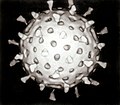Wikipedia:Today's featured article/October 21, 2012
A virus is a biological agent that reproduces inside the cells of living hosts. When infected, a host cell is forced to produce many thousands of identical copies of the original virus, at an extraordinary rate. Unlike most living things, viruses do not have cells that divide; new viruses are assembled in the infected host cell. Over 2,000 species of viruses have been discovered. A virus consists of two or three parts: genes, made from either DNA or RNA, long molecules that carry the genetic information; a protein coat that protects the genes; and in some, an envelope of fat that surrounds and protects them when they are not contained within a host cell. Viruses vary in shape from the simple helical and icosahedral to more complex structures. They spread in many different ways. Whereas viruses such as influenza are spread through the air by people when they cough or sneeze, others such as norovirus, which are transmitted by the faecal–oral route, contaminate hands, food and water. Rotavirus is often spread by direct contact with infected children. The human immunodeficiency virus, HIV, is one of several major viruses that are transmitted during sex. Viral infections often cause disease in humans and animals; however, they are usually eliminated by the immune system, conferring lifetime immunity to the host for that virus. (more...)
Recently featured: Andjar Asmara – United States v. Wong Kim Ark – Sarah Churchill, Duchess of Marlborough

